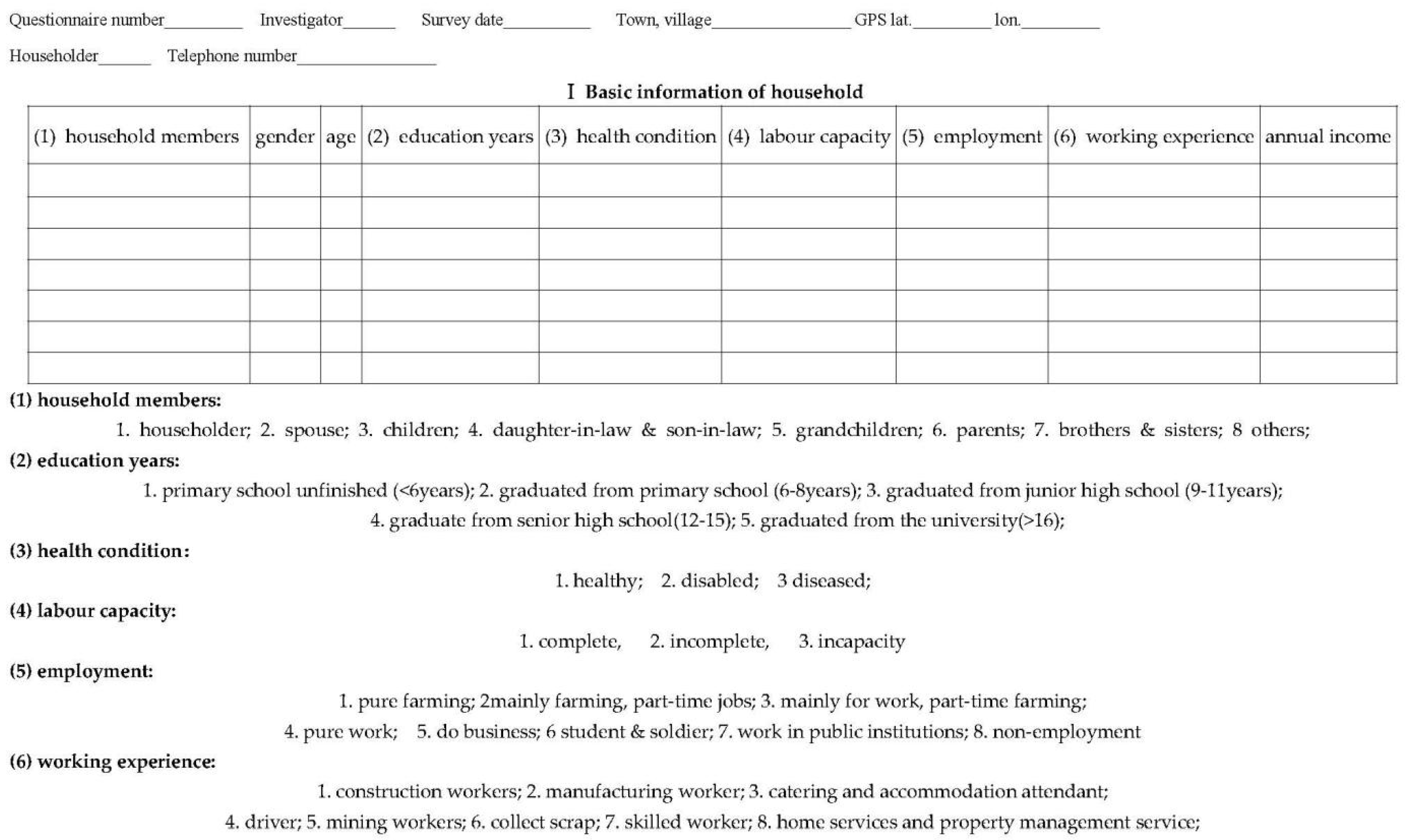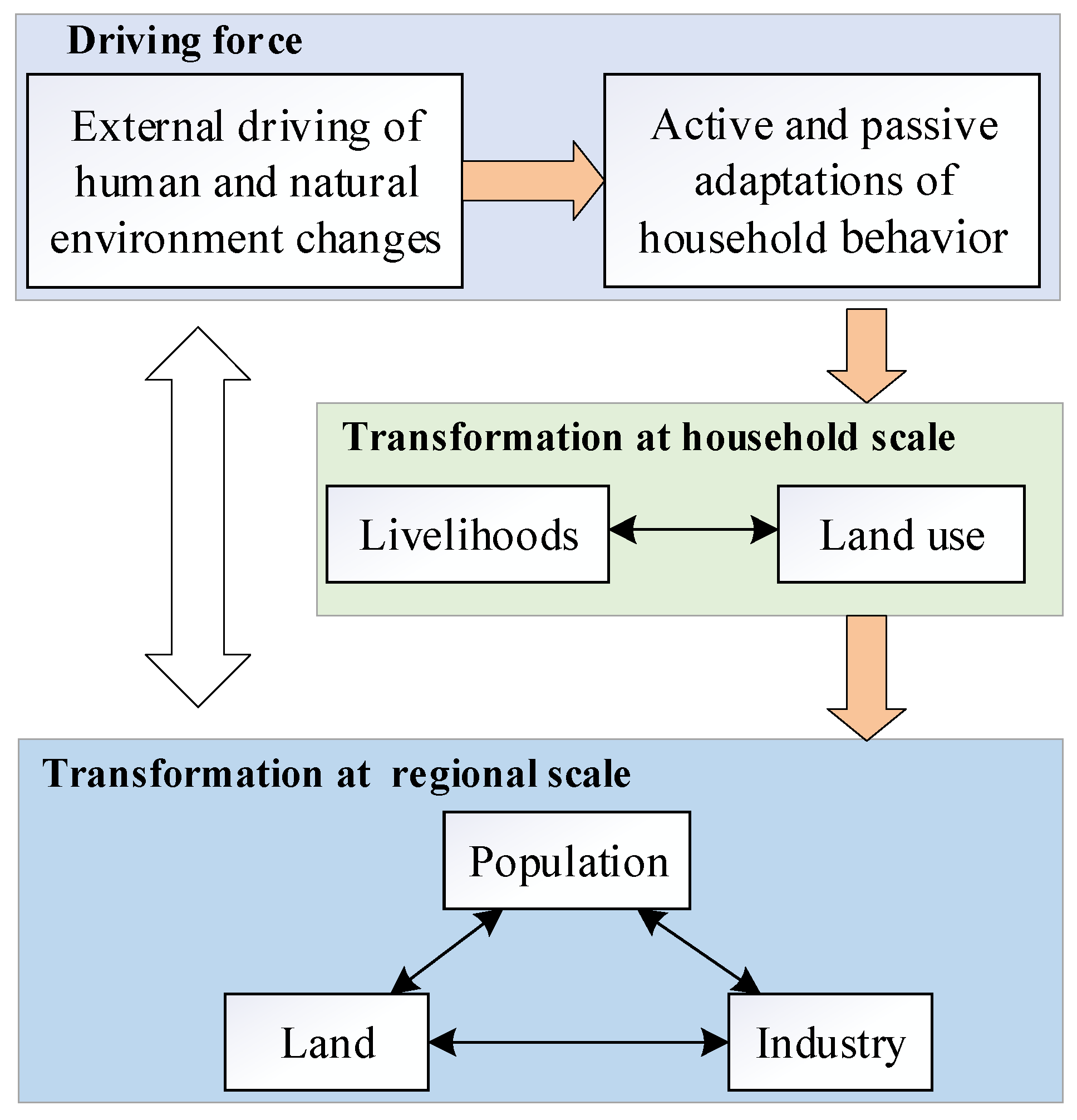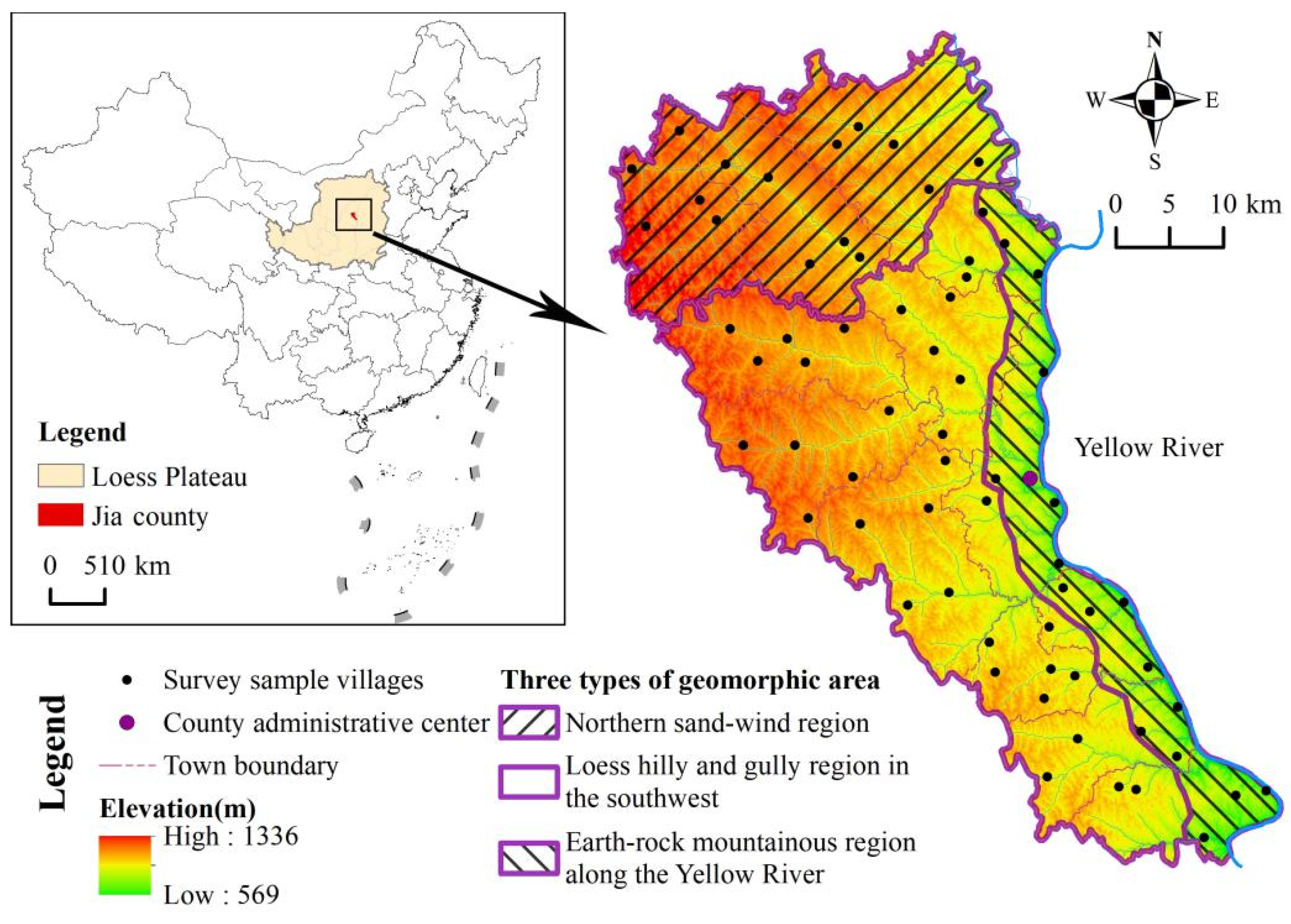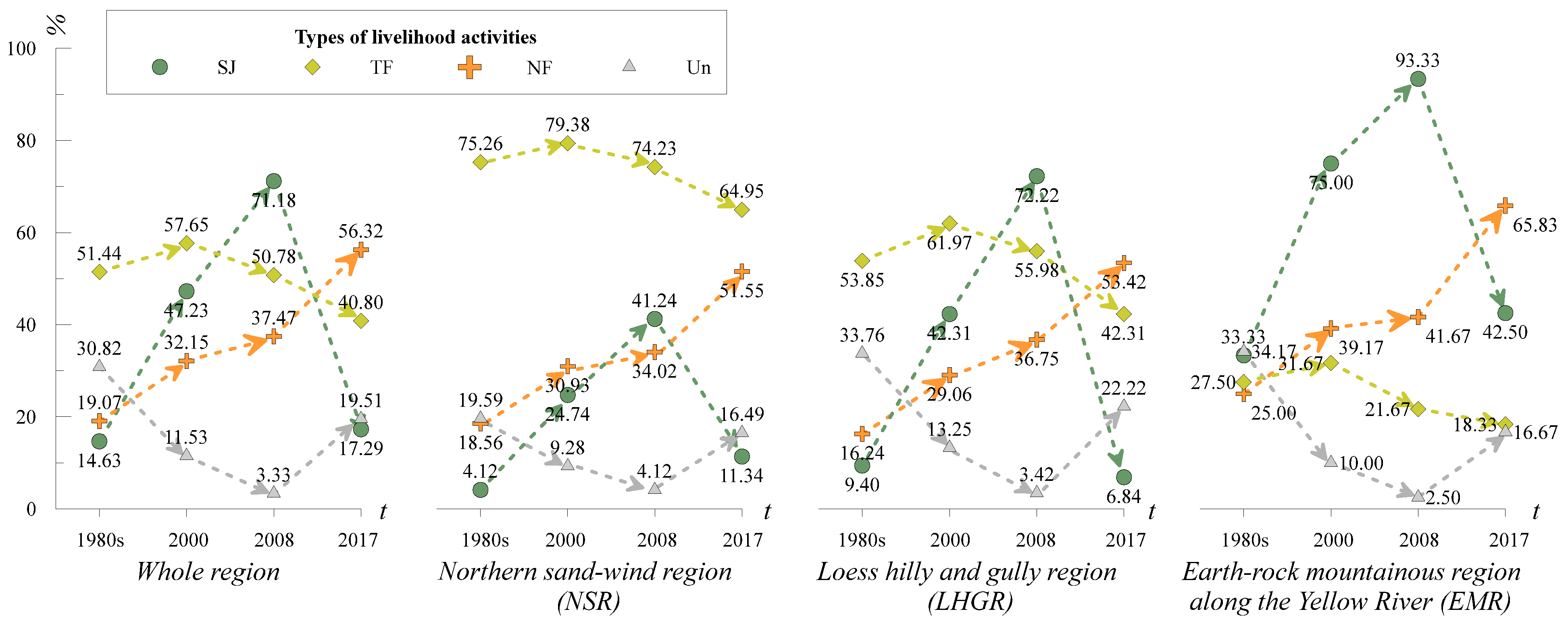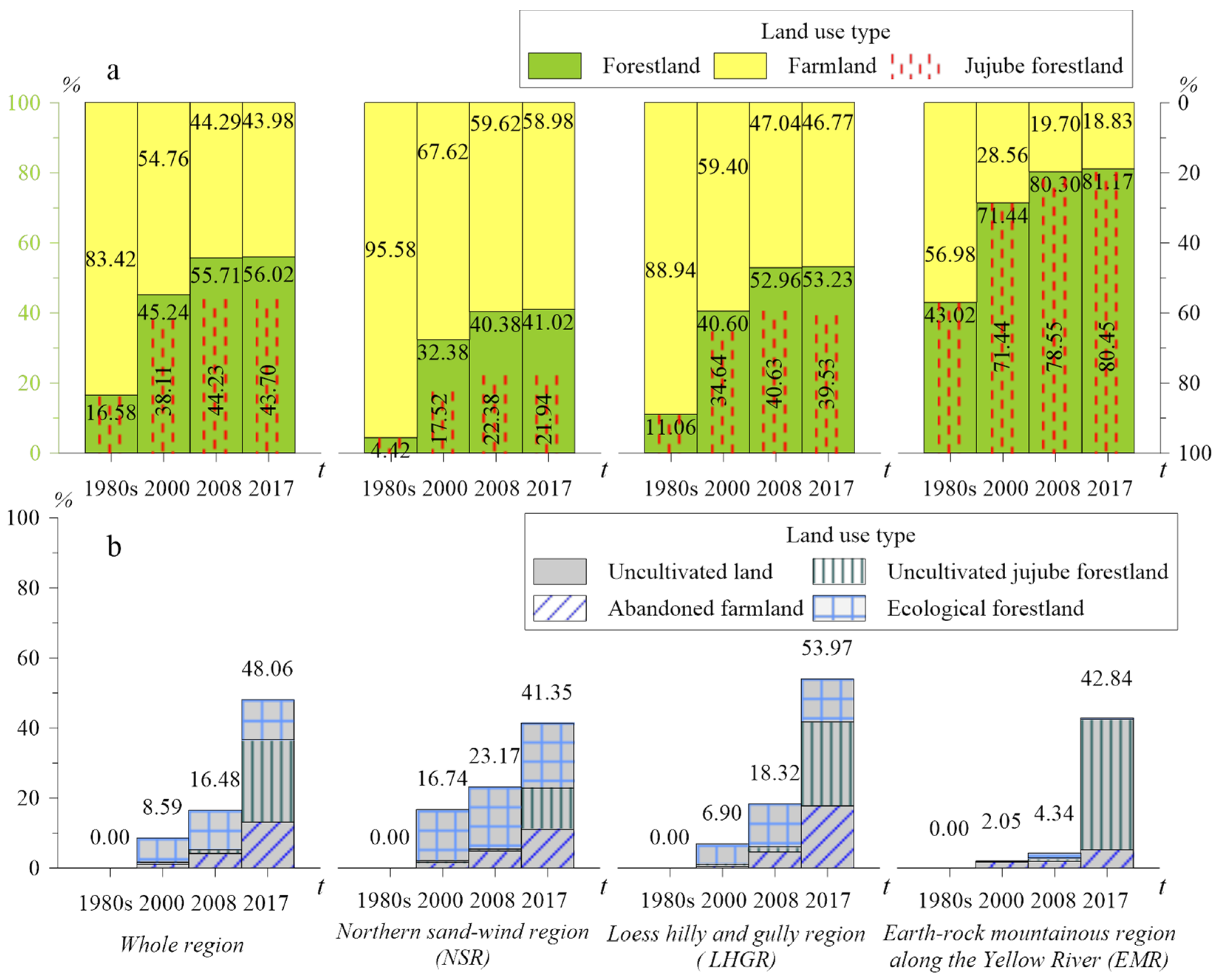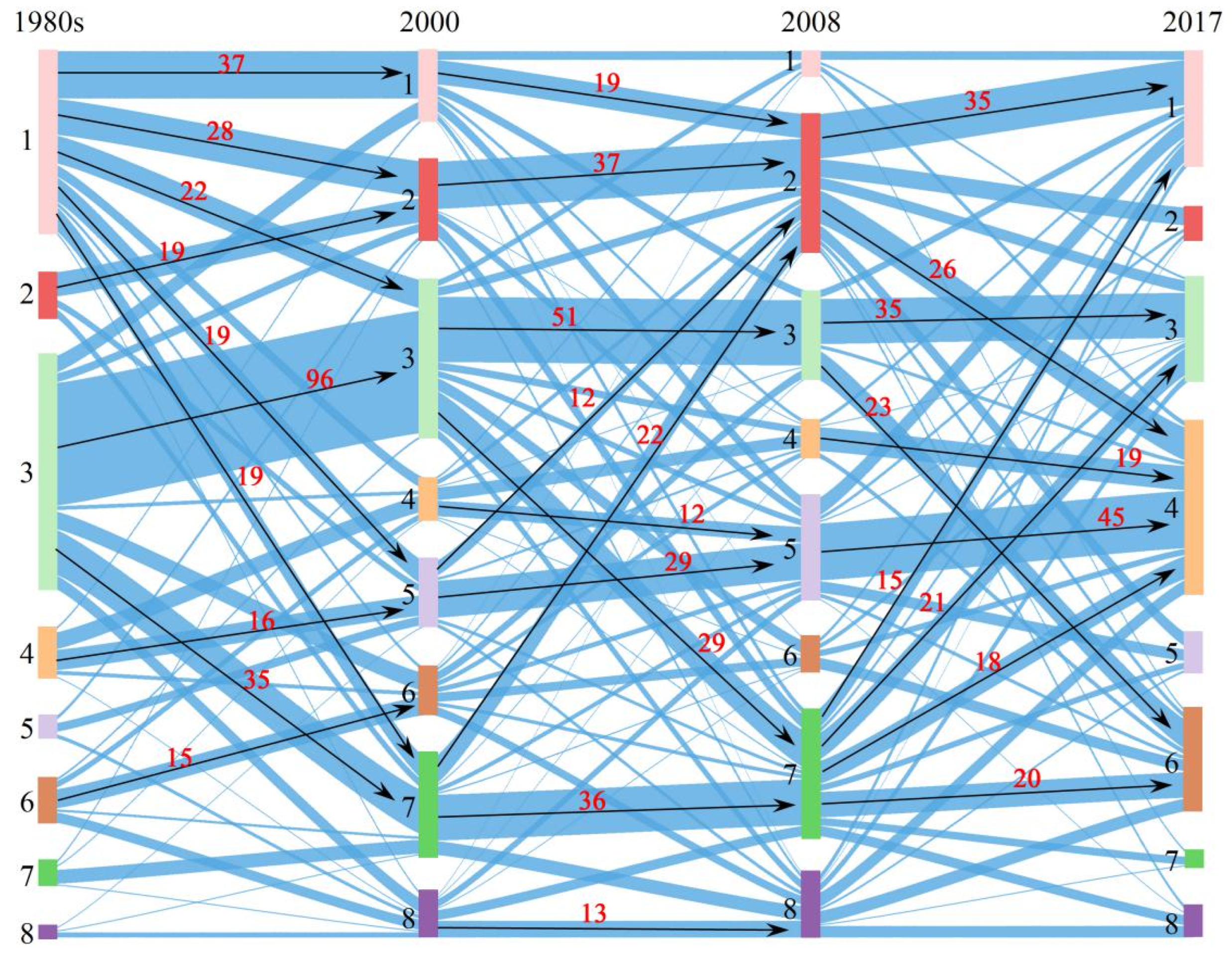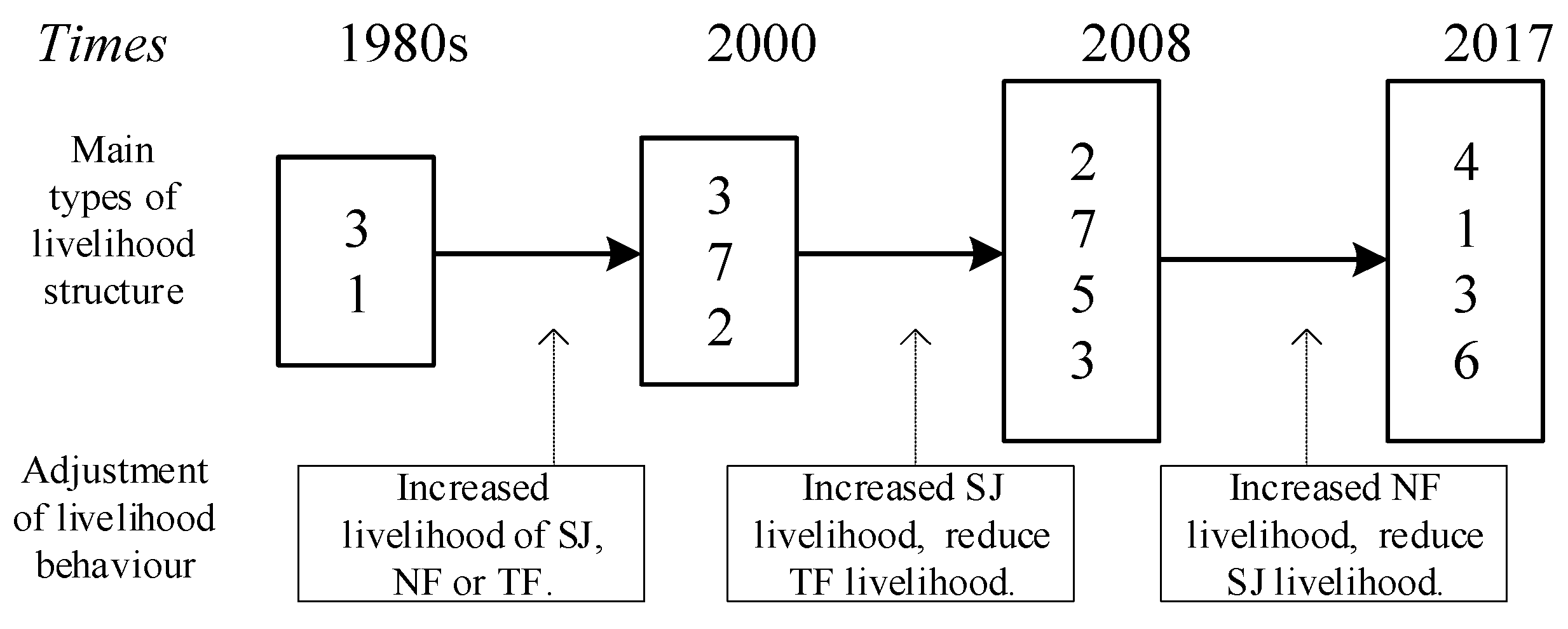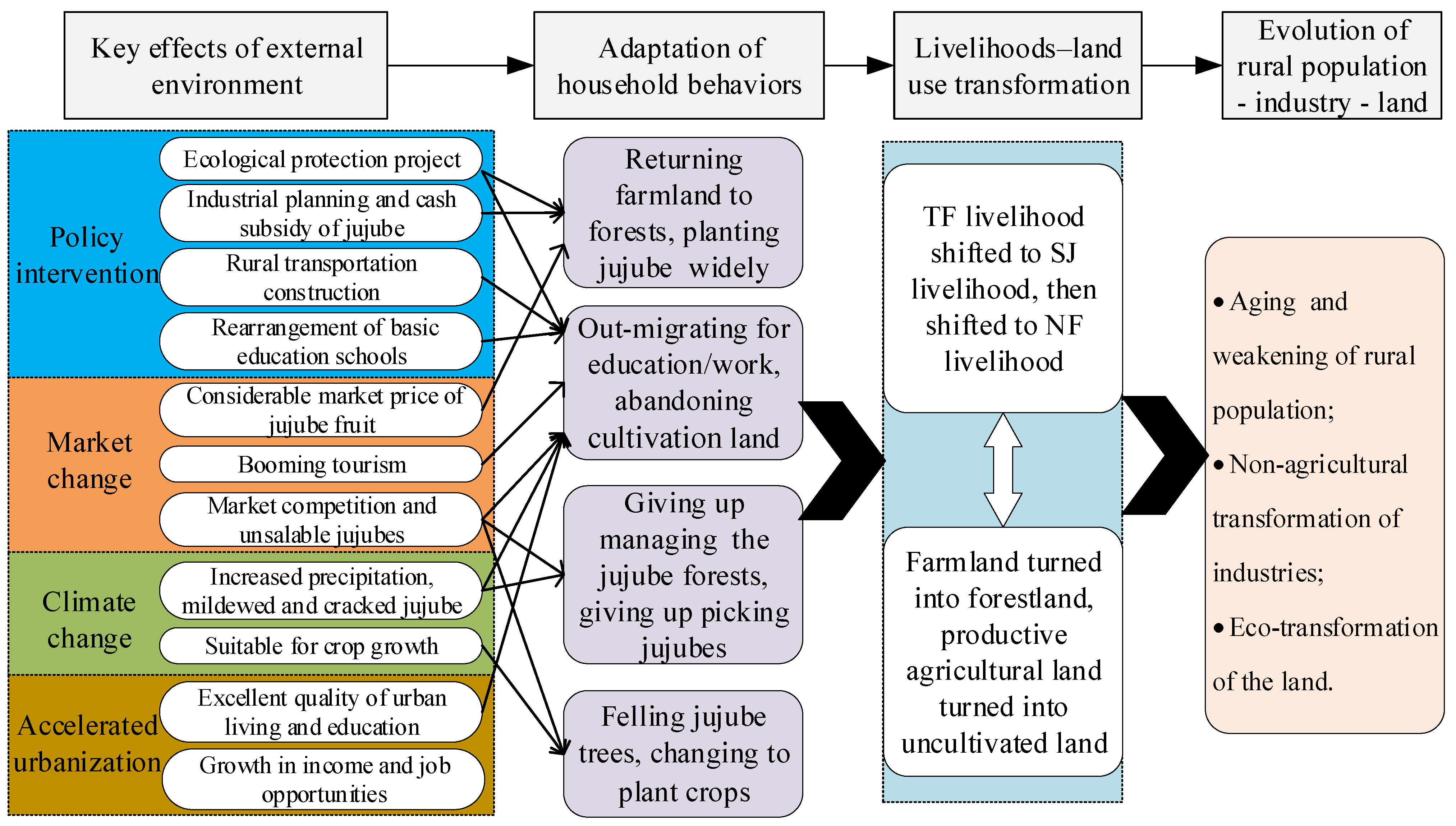1. Introduction
The spatial structure of urban and rural regional systems has changed significantly under global environmental change; rural sustainability has become one of the important development directions and key research fields of international geography, whilst rural transformation has become a worldwide topic [
1,
2,
3,
4,
5]. Rural change is seen as the interrelated consequences of larger technical, economic, and social changes on a global scale, a perspective which has come to be known under the term ‘rural restructuring’ or ‘rural transformation’ [
1,
6,
7,
8,
9]. In the mid-1960s, the problem of rural development attracted the attention of scholars from Germany, Britain, the United States, and Japan, and formed many prominent theories, including the stage theory of rural development, location theory, and dual-structure theory [
10,
11]. At present, rural transformation has been gradually concerned by scholars in the fields of rural geography, rural sociology, rural economics, and other disciplines. The main contents include analyzing the spatial–temporal stages, types, and modes of transformation [
12,
13]; measuring rural development degree [
9,
14]; discussing the influencing factors and mechanisms [
15,
16]; and conducting optimization policy and strategy research [
17]. Some scholars have discussed the impact of rural transformation on the ecological environment, poverty reduction, residents’ happiness, and quality of life [
18,
19,
20]. There is an interactive relationship between rural transformation and the agricultural eco-environment, and the deterioration of the agricultural eco-environment poses great challenges to sustainable agriculture [
21,
22].
Long et al. [
9] define rural-transformation development as the reconstruction of social and economic forms and regional spatial patterns in rural areas, which mainly involves changes in the spatial organization structure, rural industrial development mode, employment mode, consumption structure, relations between industry and agriculture, and relations and differences between urban and rural areas, amongst others. This definition has gained broad consensus. Population, land, and industry are the three core elements affecting rural-transformation development [
23]; the change in any element will drive the other elements to specific direction change, such as the change in industrial structure reflected by the corresponding land use change, and the upgrading of the industrial structure to promote the transformation of the rural employment structure. The separation of rural human with land leads to the abandonment of land [
9]. The dynamic mechanism of rural transformation can be divided into three categories. The exogenous aspect attaches importance to the role of urbanization, whereas the endogenous aspect emphasizes local resource endowment, networks, the characteristic economy and rural idyllic life; the comprehensive aspect is endogenous and exogenous factors in rural development [
24].
Since the middle of the 20th century, Western countries have experienced the process from the productive countryside to the consumption countryside, then to the multi-function countryside, and, finally, to the global countryside [
25,
26]. Woods [
27] identified the countryside, since the start of the 21st century, as a global countryside and advocated rural reconstruction. In the process of globalization, natural resources, geographical location, local and non-local political negotiation, and other factors have caused global rural differentiation, and most of the traditional agricultural villages are gradually declining due to rural population loss and capital withdrawal [
3,
12]. Since the middle of the 20th century, China’s rural areas have undergone a series of economic and management system reforms, such as land reform, the household contract responsibility system, tax and fee system reform, urban–rural integration, beautiful countryside construction, the rural revitalization strategy, and so on [
28]. Industrialization and urbanization have driven significant changes in the core elements of the rural regional system, such as land, capital, and labor [
9]. China’s rural areas are undergoing continuous transformation and development [
9,
29]. Owing to regional differences in resource endowment, economic foundation, and policy environment, the modes and mechanisms of rural transformation also vary amongst regions [
30]. Therefore, rural transformation presents significant characteristics of zonal evolution. The villages located in the developed coastal areas of eastern China show the mode of small towns and modern rural construction led by township enterprises [
22,
29]. In central China, the rural areas located in the agricultural plains or the ecological conservation areas have formed a rural construction model led by the export of labor services and distinctive industries [
31]. The functions of rural tourism, leisure, and agricultural tourism have been rapidly strengthened. In the Loess Plateau, most rural areas rely on traditional agriculture, which generally has a lack of a resource base, sufficient development foundation, and dynamic support for economic transformation; therefore, rural transformation largely depends on the bottom-up thrust of households [
31,
32,
33].
The household is the most basic social and agricultural production unit in rural areas [
33]. It not only responds directly to the external environment [
34], such as climate change [
35,
36,
37,
38], market change [
39], urbanization [
40], and policy intervention [
41], but it is also the most direct promoter of the rural-transformation process [
42]. The land is the carrier of household behaviors in society and production, and the allocation of land resources will affect the choice of livelihood activities [
40,
43]. The land use changes usually correspond to the transformation of economic, social, and eco-environment development stages, and can reflect the structural changes in the rural population and industrial elements in a region [
44]. In addition, land use and land cover change show strong ecological effects [
45,
46]. Uncultivated land is conducive to the natural restoration of soil and vegetation and can gradually evolve into forest or shrub land for soil and water conservation, which provides the basic conditions for the improvement in the overall ecological environment of the region [
47,
48]. On the other hand, the change in livelihood activities is inevitably reflected in the change in households’ land use [
33,
49], and the over-reliance of rural livelihood on land resources has resulted in the decline of rural ecological quality, such as the fact that farming was found to be the activity with the most detrimental ecological impact, followed by processing and labor work [
50].
At present, researchers are more interested in the process of urban–rural integration and transformation in suburban, rapidly industrialized areas, including rural–urban migration, land urbanization, and the non-agriculturalization of industry and labor [
3,
15,
29,
51]. Most research findings are based on sub-regional levels or national levels, and use macro-statistics published by government departments, such as land use transformation [
30,
52,
53,
54], population migration, and ‘population–land–industry’ transformation [
13,
23], which are often not accessible to the policy community. Meanwhile, micro-scale studies often suffer from limited time-series data, which means that they generally only focus on the current rural transformation [
55] or qualitative reviews to track ‘landscape’ level changes [
56]. In addition, the existing micro-scale studies pay more attention to the areas with tourism resources or special cultural settlements, and use observation methods or remote-sensing methods to discuss the rural transformation and development [
57,
58,
59].
The traditional agricultural area is the core area of grain production in China and the agglomeration area of the rural population. What is the process of rural transformation in traditional agricultural-production areas? If the characteristics of land urbanization, population urbanization, and non-agricultural transformation in rural areas are not significant, does it mean that rural transformation has not taken place—especially in the Loess Plateau agricultural areas, which are characterized by an insufficient resource and development foundation and insufficient dynamic support for economic transformation [
47,
60]? The rural-transformation process of the broader traditional agricultural areas deserves the attention of the majority of scholars.
Aiming to answer above questions, we propose a conceptual model to provide a more detailed insight into the process of rural transformation, which is driven from the bottom up by the household, the smallest organizational unit in the countryside. The processes, namely, households’ livelihoods–land use, form the crux of our analysis of the process of rural transformation at the household scale. Household behavior will actively or passively adapt to the change in the external environment, and promote the changes [
16,
61], such as population migration and the abandonment of land. The external-environment change and the adaptations of households lead to the transformation of livelihoods–land use, which can reflect the structural changes in rural land cover, population, and industrial elements on a regional scale [
9,
62,
63,
64,
65]. The transformation on the regional scale will eventually feed back to the external environment. The conceptual model is shown in
Figure 1.
According to the above ideas, we conducted an empirical study based on a household survey to explore the rural livelihoods–land use transformation in traditional farming–pastoral rural areas. We aim to investigate the changes in households’ livelihoods–land use and the regional characteristics. In particular, what are the main external factors that affect the transformation in different periods, and how do household behaviors adapt and further influence transformation? This study took Jia County, located in the Loess Plateau, as the case area, to study the transformation of livelihoods–land use from 1980 to 2017, including key effects, household adaptations, and influence paths. We used micro-household surveys, ethnographic research, and trajectory analysis methods in order to focus more carefully on the bottom-up rural-transformation process driven by household adaptation to environmental change. The analysis focuses on three aspects. Firstly, we focus on the changes in the livelihood structure within the household and the resulting changes in the livelihood activities of different regions. Secondly, the study focuses on the change in household contracted land and the regional variation. Thirdly, as for the driving force of rural transformation, the study explores the key environmental factors influencing household behavior since 1980, and what kinds of adaptive changes occur in household behavior, thus promoting the rural livelihoods–land use transformation.
4. Discussion and Conclusions
4.1. Influencing Pathways of Rural Transformation
Since 1980, rural areas on the Loess Plateau have gradually changed from a traditional backward and closed environment to an open, convenient and abundant life [
47]. However, under the impact of urbanization and other factors, a large number of the rural population has been lost, and villages have been gradually hollowed out and depressed, which are in urgent need of revitalization. At the same time, as for the natural ecological environment, it has gradually improved from the bad state represented by serious soil erosion and rampant sandstorms to the suitable state of rich vegetation and clean air; now, it is moving toward the spontaneous recovery of the ecological environment. This study provides evidence for understanding how to realize rural transformation in traditional agricultural areas where urbanization and industrial transformation are not significant [
73]. Different from previous studies that identified rural transformation through land urbanization, population urbanization, and industrial non-agricultural transformation [
9,
23,
54,
74,
75], this study confirmed that there are clear transformation directions in traditional agricultural areas, namely, the non-agricultural transformation of rural livelihood and eco-transformation of land use. Such transition paths are usually hidden by official statistics, but this study provides evidence of transitions through household livelihoods–land use changes. In addition, although the foundation and range of the livelihoods–land use transitions have spatial differences, we can still find clear driving paths of rural transformation, which is consistent in the NSR, LHGR, and EMR areas, as shown in
Figure 7.
Since 1980, national and local govt. policies, climate change, market change, and regional urbanization are the key forces affecting household behaviors in traditional agricultural areas. Subsequently, household livelihoods and land use behaviors adapt to the changes actively or passively, such as returning farmland to forest, widely planting jujube, out-migrating for work, giving up jujube management, and, ultimately, leading to the transformation of households’ livelihoods–land use. Finally, the local livelihood showed a transition trajectory from the TF livelihood to SJ livelihood, and then to the NF livelihood; the local land use showed a transition trajectory from farmland to forestland, and from productive agricultural land to uncultivated land. The transformation of livelihoods–land use leads to the evolution of industry and population at the rural regional scale, which is mainly manifested as the weakening of the rural population, the non-agricultural transformation of industry, and eco-transformation of the land.
4.2. The Gap with Green Transformation
Green transformation emphasizes reducing overexploitation of natural resources and environmental degradation [
76], whilst the process of non-agricultural transformation and eco-transformation in the study area coincide with the process of green transformation to a certain extent. In the 1980s, the study area was characterized by drought, frequent sandstorms, and extremely low forest proportion. Between 1980 and 2000, under the national ecological restoration project, farmers actively responded to the call of govt. policies, and switched from a livelihood in traditional farming and animal husbandry to a jujube livelihood on a large scale, and from farmland to jujube or ecological forest land. At this stage, the forest began to rebuild, and soil and water conservation achieved important results. Between 2001 and 2008, encouraged by the market, farmers began excessive cultivation of jujube forests, which was mainly manifested by the frequent application of chemical fertilizers, pesticides, and herbicides, followed by obvious problems of fertilizer and pesticide flooding and the destruction of meadow vegetation in the countryside. Of course, due to the afforestation project, the sandstorm disaster has been significantly reduced in stage 2. Between 2009 and 2017, when precipitation increased and the jujube market cooled, the natural ecosystem also showed the simultaneous occurrence of vegetation restoration and forest damage due to the different adaptation behaviors of farmers. The former is derived from behaviors of abandoning jujube forest or transforming into non-agricultural livelihood activity, whilst the latter originated from the behaviors of a few farmers felling jujube forest and planting crops instead. In addition, at the current stage, most of the ecological forests have notably exceeded the vigorous growth period of 5–10 years, and the ecological and economic concurrent forestry such as jujube has been degraded to varying degrees, gradually losing the original ecological protection benefits [
77]. Additionally, although carbon storage has increased due to afforestation, this also reduces the water yield supply and exacerbates the water shortage on the Loess Plateau [
46]. The restoration projects of degraded forests and the projects to balance water and soil resources should be urgently implemented.
On the other hand, a gap continues to exist between rural transformation and the goals of green transformation, such as poverty reduction, robust livelihood, and rural prosperity [
76]. Different from crop planting or animal husbandry, forestry operation has a long operation cycle and poor flexibility. Therefore, when disturbances occur, the livelihood of farmers relying on forestry will become unsustainable and difficult to adjust in a short time. Since 1980, the jujube industry has experienced a process from growth and prosperity to decline, and farmers have also experienced a transition from the TF livelihood to rely on the SJ livelihood, and finally lost confidence in the SJ livelihood. By 2017, the share of the livelihood structure with the barren type reached 19.51%, an increase of 16% compared with 2008, and the share of the comprehensive type decreased from 9.66% in 2008 to 4.66%. At the same time, the livelihood diversity index decreased from 2.07 in 2008 to 1.42, both lower than the value in 2000.
Rural–urban migration and transformation, in a positive sense, can generally increase household income, help narrow the gap between urban and rural areas, and promote urban–rural integration [
9,
15,
18]. However, urbanization, counter-urbanization, and transformation have caused rural decline and inequality to a certain extent [
13,
78,
79,
80], especially in areas with a monotonous economic structure, which is manifested in the coexistence of population urbanization and a hollowing out of villages, the aging and weakening of the rural resident population, and the fragmentation of the agricultural landscape [
39,
47,
81,
82]. This process has been highlighted in the studies at the village level, whereas it is often ignored at the macro-scale [
80,
83]. In fact, the transformation on the macro-scale, such as the non-agricultural transformation of industry and the ‘citizenization’ of population, are precisely based on the phenomenon of labor loss and population loss in rural communities. It is worth noting that some scholars pointed out that rural structural transformation will lead to further divergence of economic and health inequalities in the future, such as reducing families’ access to healthy food and increasing the risk of obesity and malnutrition [
84].
We also pay attention to the transformation process of other agricultural regions on the Chinese Loess Plateau. Most rural communities show the characteristics of green transformation, such as reduced community dependence on food and subsidy income, diversified livelihood strategies, and improved environmental indicators [
32,
64,
77,
85]. In the Yangou watershed, under the influence of agricultural practices such as building terraced fields, returning farmland to forest land and grassland, and expanding orchards, almost all sloping farmlands were replanted, and the orchard area increased sharply; furthermore, the percentages of income for fruit sales and sale of labor in total income have increased dramatically [
32]. In the apple eugenic belt in the central part of the Loess Plateau, as the local government widely promoted apple planting in the early 1990s, the livelihood of rural households has also undergone a process from traditional agricultural to apple planting and then to non-agricultural [
60]. Moreover, the increased precipitation in autumn had no significant effect on the growth of apples, and the region did not show the characteristics of abandoning the apple-planting livelihood and apple land. However, it is worth considering whether farmers will significantly shift to non-agricultural livelihoods or families will fall into poverty if some factors render the apple-related livelihood to be unsustainable in the future. In November 2020, the General Office of the State Council of the People’s Republic of China issued the Opinions on Preventing the ‘Non-Grain Conversion’ of Cultivated Land to Stabilize Grain Production, explicitly prohibiting the occupation of permanent basic farmland for the forestry and fruit industry, which has a certain restriction on the expansion of apple planting scale. In addition, apple orchards currently occupying permanent prime farmland may need to be gradually converted into food crops in the future. Therefore, in the context of the policy of ensuring food security, the issues of green transformation and livelihood vulnerability of forestry communities deserve researchers’ attention.
4.3. Policy Proposals in Terms of Ecology, Livelihood, and Industry
In 2018, the Chinese government proposed the ‘Rural revitalization strategy’. Since then, the future of rural areas and the path of rural-transformation development at the micro-level have further attracted academic attention. We call for rural areas to be guided toward green transformation instead of traditional growth-oriented development strategies, which is particularly important in ecologically fragile and ecologically functional areas. The study proposes three policy suggestions to ensure the successful realization of green transformation. Firstly, the ecological value and livelihood vulnerability of rural communities should be comprehensively assessed, the ecological benefits of forest production land should be measured, farmland and other types of land should be abandoned, the decoupling of livelihoods from land use should be guided, and continuous ecological compensation for the corresponding families should be implemented. Secondly, we should increase the added value of agriculture, guide the non-agricultural development of local industries, integrate the development of agriculture with tourism and ecological industries, promote the deep processing of local agricultural and forestry products, and, subsequently, attract human capital back to rural areas. Thirdly, we should guide households to enhance the diversity of their livelihoods and reduce their vulnerability to avoid the emergence of barren livelihoods caused by changes in the external environment such as climate, market, and policy.
4.4. Conclusions
Since 1980, the rural livelihoods–land use in Jia County on the Loess Plateau of China showed a clear transformation of non-agricultural and ecological. As for livelihoods, they are manifested as a trajectory from the traditional farming livelihood to jujube-oriented and then to non-farming, and the share of traditional farming has gradually decreased, whilst that of non-farming has gradually increased and that of jujube livelihood has experienced a process of steep rising to a steep decline. As for land use, it is manifested as a large increase in uncultivated land, and farmland turned into forestland on a large scale. Of course, regional variation can be observed in the share of livelihood activities, the forest–tillage ratio, and the source of uncultivated land at different stages. Household behaviors actively or passively adapting to the change in the external environment is the power source of transformation, and climate change, market change, urbanization impact, and policy regulation are the key factors. The behaviors experienced a process from over-reclamation to reforestation and extensive planting of jujube trees, and, finally, to migrant work and land abandonment. National and local govt. policies, climate change, market change, and urban attraction are the key effects.
Of course, there are still some deficiencies in this study and further work to be carried out. On the one hand, this study adopted field survey data of the trajectory of livelihoods and land use change, but the influencing factors, households’ adaptation, and drive path only use ethnographic research methods. This qualitative-analysis method is inevitably influenced by the interviewees, reporters, and interview outline, so this study also has certain “construction” characteristics. Therefore, this study provides a clear direction for the influencing factors, paths, and driving mechanisms of rural transformation, but it still needs to be verified quantitatively in the future and widely applied internationally. On the other hand, although this study is based on the perspective of households′ livelihood and land use, due to the lack of data, it lacks the analysis of changes in rural homesteads, whereas cultivated land and rural homesteads are the important sources of rural development and land use transformation [
30]. In addition, the non-agricultural transformation of rural livelihood is accompanied by the change in rural population structure. However, the current analysis only shows the phenomenon and causes of rural population loss, aging, and weakening based on the interview materials, and the trajectory and regional impact of rural population change were not quantitatively analyzed. At present, it is a realistic challenge and inevitable choice for global rural development to solve the development dilemma and move toward revitalization. The current significant changes in rural areas, such as population return and livelihood development, agricultural modernization, and diversification of rural organizations, need to be extensively explored by international scholars in the field of rural transformation and development. It is also urgent to carry out more extensive field investigations involving multi-stakeholder rural areas.
